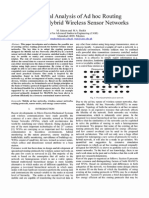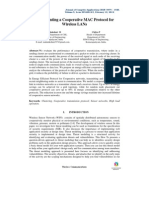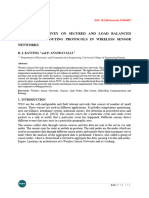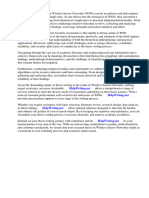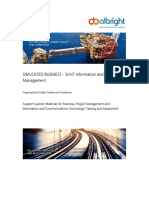0 ratings0% found this document useful (0 votes)
19 viewsPerformance Evaluation of LEACH Protocol For Wireless Sensor Network
Performance Evaluation of LEACH Protocol For Wireless Sensor Network
LEACH is the first network protocol that uses hierarchical routing for Wireless Sensor Networks to increase the life time of network. This paper gives performance of LEACH protocol considering parameters i) Packet Delivery Ratio ii) Throughput iii) Delay iv) lifetime.
Copyright:
© All Rights Reserved
Available Formats
Download as PDF, TXT or read online from Scribd
Performance Evaluation of LEACH Protocol For Wireless Sensor Network
Performance Evaluation of LEACH Protocol For Wireless Sensor Network
0 ratings0% found this document useful (0 votes)
19 views5 pagesLEACH is the first network protocol that uses hierarchical routing for Wireless Sensor Networks to increase the life time of network. This paper gives performance of LEACH protocol considering parameters i) Packet Delivery Ratio ii) Throughput iii) Delay iv) lifetime.
Original Title
JYEC10089(20).07
Copyright
© © All Rights Reserved
Available Formats
PDF, TXT or read online from Scribd
Share this document
Did you find this document useful?
Is this content inappropriate?
LEACH is the first network protocol that uses hierarchical routing for Wireless Sensor Networks to increase the life time of network. This paper gives performance of LEACH protocol considering parameters i) Packet Delivery Ratio ii) Throughput iii) Delay iv) lifetime.
Copyright:
© All Rights Reserved
Available Formats
Download as PDF, TXT or read online from Scribd
Download as pdf or txt
0 ratings0% found this document useful (0 votes)
19 views5 pagesPerformance Evaluation of LEACH Protocol For Wireless Sensor Network
Performance Evaluation of LEACH Protocol For Wireless Sensor Network
LEACH is the first network protocol that uses hierarchical routing for Wireless Sensor Networks to increase the life time of network. This paper gives performance of LEACH protocol considering parameters i) Packet Delivery Ratio ii) Throughput iii) Delay iv) lifetime.
Copyright:
© All Rights Reserved
Available Formats
Download as PDF, TXT or read online from Scribd
Download as pdf or txt
You are on page 1of 5
International Journal of Innovative Research in Advanced Engineering (IJIRAE) ISSN: 2349-2163
Volume 1 Issue 6 (July 2014) http://ijirae.com
_______________________________________________________________________________________________________
2014, IJIRAE- All Rights Reserved Page - 141
Performance Evaluation of LEACH Protocol for Wireless
Sensor Network
Leena Y.Barai Mahendra A. Gaikwad
PG Student, M-Tech (Electronics) Principal
B. D. College of Engineering B. D. College of Engineering
Sewagram (Wardha) Sewagram (Wardha)
Maharashatra ( India ) Maharashatra ( India )
Abstract ---This paper gives performance of LEACH protocol. LEACH is the first network protocol that uses hierarchical
routing for wireless sensor networks to increase the life time of network. All the nodes in a network organize themselves into
local clusters, with one node acting as the cluster-head. All non-cluster-head nodes transmit their data to the cluster-head,
while the cluster-head node receive data from all the cluster members, perform signal processing functions on the data (e.g.,
data aggregation), and transmit data to the remote base station. Therefore, being a cluster-head node is much more energy-
intensive than being a non-cluster-head node. Thus, when a cluster-head node dies all the nodes that belong to the cluster lose
communication ability. This paper gives performance of LEACH protocol considering parameters i) Packet Delivery Ratio ii)
Throughput iii) Delay iv) lifetime.
Keyword: -LEACH protocol, WSN, energy-efficient.
I. INTRODUCTION
A Wireless Sensor Network (WSN) holds the promise of a smart communication paradigm which enables setting up an
intelligent network capable of handling application that involve from user requirements. However due to nature of WSN
researches face new challenges related to the design of algorithm and protocol.
Wireless Sensor Networks (WSNs) can be defined as a self-configured and infrastructure-less wireless networks to
monitor physical or environmental conditions, such as temperature, sound, vibration, pressure, motion or pollutants and to
cooperatively pass their data through the network to a main location or sink where the data can be observed and analyzed. A sink
or base station acts like an interface between users and the network. One can retrieve required information from the network by
injecting queries and gathering results from the sink. Typically a wireless sensor network contains hundreds of thousands of
sensor nodes. The sensor nodes can communicate among themselves using radio signals. A wireless sensor node is equipped with
sensing and computing devices, radio transceivers and power components. The individual nodes in a wireless sensor network
(WSN) are inherently resource constrained: they have limited processing speed, storage capacity, and communication bandwidth.
After the sensor nodes are deployed, they are responsible for self-organizing an appropriate network infrastructure often with
multi-hop communication with them.
Thus, the sensor network is a bridge between the real world and computation world. Some important properties for a good sensor
network protocols are:
a) Ease of deployment: Sensor nodes may communicate in absence of established network also.
b) System lifetime: Sensor networks must extremely energy efficient.
c) Latency: Communication between nodes and base station should be timely manner.
d) Quality of service: End user does not require all data in the network so data aggregation is important issue in quality
of service.
Wireless sensor network enable new application and require non-conventional paradigms for protocol design due to several
constrains. Owing to the requirements for low device complexity together with low energy consumption and long network
lifetime. So nowadays most of the researches concentrated at design of energy efficient protocol.
II. Review of LEACH Protocol:-
This review paper is built on the work mentioned in [1],[2]. LEACH comes under the family of proactive network protocols, with
small changes. In proactive protocols [3]the node sense and send it to the base station periodically. Whereas reactive network
protocols like TEEN performs instantaneously for critical data. For achieving the design goal for LEACH protocol, the following
techniques are
i) Randomized and self-configuring formation
ii) Data aggregation
iii) Local control on data transmission.
LEACH is the first hierarchical cluster based routing Protocol, distributed algorithm is used to form clusters in network area. For
each cluster there is a cluster head node which is responsible for data aggregation and sends the important data in its TDMA
(Time Division Multiple Access) slot to the base station, where these data is needed using CDMA (Code Division Multiple
International Journal of Innovative Research in Advanced Engineering (IJIRAE) ISSN: 2349-2163
Volume 1 Issue 6 (July 2014) http://ijirae.com
_______________________________________________________________________________________________________
2014, IJIRAE- All Rights Reserved Page - 142
Access).Few numbers of nodes become the cluster head which act as the router to the base station. Energy dissipation is less as
data transmission is done by only cluster head node. Data aggregation technique is used, because there is a possibility of
correlated data in neighboring nodes of the same cluster. So data is processed locally in LEACH protocol.
Assumptions for development of LEACH:-
The sensor nodes and the underlying network model. For sensor nodes assume that all nodes can transmit with enough power to
reach the BS if needed, that nodes can use the power control to vary the amount of transmit power and computational power to
support MAC protocol and perform signal processing computations. For the network model, where the nodes always have data to
send to the end user and nodes and nodes located close to each other have correlated data.
Stages in LEACH:-
LEACH
Cluster Set-up Steady State
1) Cluster Head selection 1) Data communication to CH
2) Advertisement phase 2) Data fusion.
3) Cluster formation 3) Data communication to BS
4) Schedule creation
Timeline of LEACH protocol:-
4. (A) Set-up phase
In LEACH, nodes take autonomous decisions to form clusters by using a distributed algorithm without any centralized control.
Here no long-distance communication with the base station is required and distributed cluster formation can be done without
knowing the exact location of any of the nodes in the network. In addition, No global communication is needed to set up the
clusters. The cluster formation algorithm should be designed such that nodes are cluster-heads approximately the same number of
time, assuming all the nodes start with the same amount of energy [8]. Finally, the cluster-head nodes should be spread
throughout the network, as this will minimize the distance the non-cluster-head nodes need to send their data. A sensor node
chooses a random number, r, between 0 and 1.
Let a threshold value be I(n)
I(n) =_
p
1-pjmod[
1
p
[
0
---- ne0
Otherwise
This random number is less than a threshold value, I(n), the node becomes a cluster-head for the current round. The threshold
value is calculated based on the above given equation that incorporates the desired percentage to become a cluster-head, the
current round, and the set of nodes that have not been selected as a cluster-head in the last(1/P) rounds, p is cluster head
probability. After the nodes have elected themselves to be cluster-heads, it broadcasts an advertisement message (ADV). This
message is a small message containing the node's ID and a header that distinguishes this message as an announcement message.
Each non-cluster-head node determines to which cluster it belongs by choosing the Cluster head that requires the minimum
communication energy, based on the received signal strength of the advertisement from each cluster-head. After each node has
decided to which cluster it belongs, it must inform the cluster-head node that it will be a member of the cluster. Each node
transmits a join-request message (Join- REQ) back to the chosen cluster-head. The cluster-heads in LEACH act as local control
centers to co-ordinate the data transmissions in their cluster [9]. The cluster-head node sets up a TDMA schedule and transmits
this schedule to the nodes in the cluster. This ensures that there are no collisions among data messages and also allows the radio
components of each non cluster-head node to be turned off at all times except during their transmit time, thus minimizing the
energy dissipated by the individual [8][10].
International Journal of Innovative Research in Advanced Engineering (IJIRAE) ISSN: 2349-2163
Volume 1 Issue 6 (July 2014) http://ijirae.com
_______________________________________________________________________________________________________
2014, IJIRAE- All Rights Reserved Page - 143
4 (B) Steady-State Phase
The steady-state operation is broken into frames where nodes send their data to the cluster-head at most once per frame during
their allocated transmission slot. The set-up phase does not guarantee that nodes are evenly distributed among the cluster head
nodes. Therefore, the number of nodes per cluster is highly variable in LEACH, and the amount of data each node can send to the
cluster-head varies depending on the number of nodes in the cluster. To reduce energy dissipation, each non-cluster-head node
uses power control to set the amount of transmits power based on the received strength of the cluster-head advertisement. The
radio of each non-cluster-head node is turned off until its allocated transmission time. Since all the nodes have data to send to the
cluster-head and the total bandwidth is fixed, using a TDMA schedule is efficient use of bandwidth and represents a low latency
approach, in addition to being energy-efficient[5][9]. The cluster-head must keep its receiver on to receive all the data from the
nodes in the cluster. Once the cluster-head receives all the data, it can operate on the data and then the resultant data are sent from
the cluster-head to the base station.
Simulation Parameter:-
Sr.No No. of Item description specification No. of Item description specification
1 Simulation Area 300 X 300
2 No. of nodes 11
3 Channel type Channel / Wireless channel
4 Simulation time 300ns
5 Antenna model Antenna / Omni antenna
6 Link Layer Type LL
7 Energy Model Battery
8 Communication model Bi-directional
9 Interface queue type Queue / drop tail / priqueue
Evaluation of LEACH protocol:-
Performance of LEACH protocol evaluated in NS2 simulator by following
I ) Throughput ii ) Energy of cluster heads iii) Packet Delivery Ratio iv) End to end delay
i) Throughput is the average data packets received at the destination (i.e at base station). Throughput usually measured
in data packets per second (Bits/sec or bps)
Fig. Time Verses Throughput
From above graph up to 40 seconds all packets not delivered at base station from 0 to 40 seconds maximum packets drop but after
40 sec to 100 sec maximum packets delivered at destination.
ii) Packet Delivery Ratio is the ratio of packets send to the number of packets received at destination. The greater value
of packet delivery ratio means better performance of protocol.
International Journal of Innovative Research in Advanced Engineering (IJIRAE) ISSN: 2349-2163
Volume 1 Issue 6 (July 2014) http://ijirae.com
_______________________________________________________________________________________________________
2014, IJIRAE- All Rights Reserved Page - 144
Fig :- Time Verses Packet Delivery Ratio
From above figure Packet delivery ratio for LEACH protocol evaluate graph shows that maximum packets delivered at
destinations .As greater value of packet delivery ratio means better performance of protocol.
iii) Energy of clusters head
As we focus on energy efficiency of wireless sensor network so energy of sensor node is important parameter
Fig. Number of clusters verses energy
.
Fig 4:- Time Verses Delay
Total energy of network during communication with base station not possible evaluate in LEACH because of LEACH elect
cluster heads in random fashion .So above graph drawn between no. of clusters verses energy
iv) End to end delay is average packet to arrive in destination .It also included delay caused by route discovery process and queue
in the data packet transmission. Only data packets that successfully delivered to destination that counted Figure shows that end to
end delay which the average data packet to arrive at the destination. From above graph end to end delay increases with time which
is limitation of LEACH protocol.
International Journal of Innovative Research in Advanced Engineering (IJIRAE) ISSN: 2349-2163
Volume 1 Issue 6 (July 2014) http://ijirae.com
_______________________________________________________________________________________________________
2014, IJIRAE- All Rights Reserved Page - 145
LEACH Assumptions/ Limitations:-
As LEACH is (Low Energy Adaptive Clustering Hirarchy) protocol is able to increase network life time but there are still some
factors to improve in assumptions of LEACH protocol. LEACH assumes that homogeneous distribution of sensor nodes in the
given area. But it not realistic. LEACH assumes that nodes in always have data to send to the end user have correlated data. It is
not possible no of clusters heads uniformly distributed throughout network. It may possible that all cluster heads placed nearby
due to this information other part of network unable to reach to the destination.
CONCLUSION:-
Wireless Sensor Network (WSN) consists of base stations (BS) and several nodes which are unattended and have limited resource
and they can work until the energy exists inside them. In this paper we take overview of LEACH protocol with its assumptions
and performance evaluated considering some properties throughput, packet delivery ratio, energy of cluster head, end to end
delay. But out of these properties we observed end to end delay is linearly increases with time. So this is drawback that must be
overcome to increase lifetime of network and make LEACH protocol energy efficient.
VIII. REFERENCES
[1]Heinzelman.W.B.,Chandrakasan.A.P.,Balakrishnan.HAn application-specific protocol architecture for wireless
microsensornetworksIEEE transactions on Wireless Communication, Vol. 1, Issue. 4, 2002, pp 660-670
[2]Yuhua Liu, Yongfeng Zhao, JingjuGao, A New Clustering mechanism based on LEACH Protocol, 2009 International Joint
Conference on Artificial Intelligence, 2009. JCAI '09. pp 715-718
[3]Beibei Wang & Chong Shen& Jing Li Study and Improvement on LEACH protocol in WSNS International Jouranal of
Wireless Communication and Networking ISSN :0975-7163
[4]V. Loscr, G. Morabito, S. Marano, A two levels hierarchy for low energy adaptive clustering hierarchy (TL-LEACH),
Vehicular Technology Conference, 2005, Vol. 3, pp 1809-1813
[5]Haosong Gou and YounghwanYooAn Energy Balancing LEACH Algorithm for Wireless Sensor Networks 978-0-7695-
3984-3/10 $26.00 2010 IEEE
[6] Jlan-FengYann& Yuan-Liu LiuImproved LEACH Routing Protocol ForLarge Scale Wireless Sensor Networks Routing
978-1-4577-0321-8/11/$26.00 2011 IEEE
[7] Ms.V.MuthuLakshmi Advanced LEACH Protocol in Large scale WirelessSensor Networks Volume 4, Issue 5, May-2013
ISSN 2229-5518
[8] NavneetVerma, Dr. Devendra Prasad, MukeshChawla Energy and Throughput of Hierarchical Routing Protocol Leach and
Leach-C for WSNS: A Review International Journal of Research in Management, Science & Technology Vol.1, No. 1
[9]Meenakshi Sharma, Anil Kumar. Shaw Transmission Time and Throughput analysis ofEEE LEACH, LEACH and Direct
TransmissionProtocol: A Simulation Based ApproachAdvanced Computing: An International Journal ( ACIJ ), Vol.3, No.5,
September 2012.
[10] Rajesh Patel, Sunil Pariyani Energy and Throughput Analysis of Hierarchical Routing Protocol (LEACH) for Wireless
Sensor Network International Journal of Computer Applications (0975 8887) Volume 20 No.4, April 2011
[11]M.Shankar, Dr.M.Sridar, Dr.M.RajaniPerformance Evaluation of LEACH Protocol inWireless Network International
Journal of Scientific & Engineering Research, Volume 3, Issue 1, January-2012ISSN 2229-5518
You might also like
- ISE High Level Design (HLD) - Cisco CommunityDocument20 pagesISE High Level Design (HLD) - Cisco CommunityEider Diaz100% (1)
- Comprehensive Study of Routing Management in Wireless Sensor Networks-Part-2Document11 pagesComprehensive Study of Routing Management in Wireless Sensor Networks-Part-2tranhoahueNo ratings yet
- Deterministic Relay Node Based Improved Leach Protocol For Wireless Sensor NetworkDocument4 pagesDeterministic Relay Node Based Improved Leach Protocol For Wireless Sensor NetworkIJIRSTNo ratings yet
- Distance Based Cluster Formation Technique For LEACH Protocol in Wireless Sensor NetworkDocument5 pagesDistance Based Cluster Formation Technique For LEACH Protocol in Wireless Sensor NetworkInternational Journal of Application or Innovation in Engineering & ManagementNo ratings yet
- IJCER (WWW - Ijceronline.com) International Journal of Computational Engineering ResearchDocument7 pagesIJCER (WWW - Ijceronline.com) International Journal of Computational Engineering ResearchInternational Journal of computational Engineering research (IJCER)No ratings yet
- Energy Efficiency Techniques For Wirelesssensor Networks A ReviewDocument5 pagesEnergy Efficiency Techniques For Wirelesssensor Networks A ReviewEdwardNo ratings yet
- Upload - 1764473-DATA TRANSMISSION IN WIRELESS SENSOR NETWORK BY CLUSTERING TECHNIQUEDocument5 pagesUpload - 1764473-DATA TRANSMISSION IN WIRELESS SENSOR NETWORK BY CLUSTERING TECHNIQUEpraveen.malikupNo ratings yet
- En - LEACH Routing Protocol For Wireless Sensor Network: Mr. Rajesh Halke, Mrs. Kulkarni V. ADocument4 pagesEn - LEACH Routing Protocol For Wireless Sensor Network: Mr. Rajesh Halke, Mrs. Kulkarni V. AAatuif RahmaniNo ratings yet
- 2 Vol 3Document7 pages2 Vol 3yash992No ratings yet
- Research Article: Cross-Layer Support For Energy Efficient Routing in Wireless Sensor NetworksDocument10 pagesResearch Article: Cross-Layer Support For Energy Efficient Routing in Wireless Sensor NetworksNaveen ChilamkurtiNo ratings yet
- Ijaiem 2013 04 20 051Document6 pagesIjaiem 2013 04 20 051International Journal of Application or Innovation in Engineering & ManagementNo ratings yet
- An Enhanced Cluster Based Multi-Hop Routing Technique in Wireless Sensor Network Using AODV ProtocolDocument5 pagesAn Enhanced Cluster Based Multi-Hop Routing Technique in Wireless Sensor Network Using AODV ProtocolEditor IJRITCCNo ratings yet
- Sciencedirect: Wireless Sensor Network Aided Cognitive Femtocell NetworksDocument6 pagesSciencedirect: Wireless Sensor Network Aided Cognitive Femtocell Networksradhakodirekka8732No ratings yet
- Data Dissemination Methods in Wireless Sensor Networks: A SurveyDocument5 pagesData Dissemination Methods in Wireless Sensor Networks: A SurveyIJSTENo ratings yet
- Protocols For Self-Organization of A Wireless Sensor NetworkDocument24 pagesProtocols For Self-Organization of A Wireless Sensor NetworkMukesh KumarNo ratings yet
- 5414ijasuc02 PDFDocument9 pages5414ijasuc02 PDFVương Ngọc QuangNo ratings yet
- Wireless Sensor Network Protocol With PEGASIS GA To Enhance The Network LifetimeDocument4 pagesWireless Sensor Network Protocol With PEGASIS GA To Enhance The Network LifetimeEditor IJTSRDNo ratings yet
- Abstract: Due To Significant Advances in Wireless Modulation Technologies, Some MAC Standards Such As 802.11aDocument6 pagesAbstract: Due To Significant Advances in Wireless Modulation Technologies, Some MAC Standards Such As 802.11aVidvek InfoTechNo ratings yet
- IOSR JournalsDocument8 pagesIOSR JournalsInternational Organization of Scientific Research (IOSR)No ratings yet
- Hierarchical Routing Protocols in Wireless Sensor NetworkDocument5 pagesHierarchical Routing Protocols in Wireless Sensor NetworkAshish D PatelNo ratings yet
- Implementation of DYMO Routing Protocol and Its Comparative Performance Analysis With DSR ProtocolDocument9 pagesImplementation of DYMO Routing Protocol and Its Comparative Performance Analysis With DSR ProtocolIJRASETPublicationsNo ratings yet
- The Comparison of Routers by Firms Cisco, Juniper and HuaweiDocument8 pagesThe Comparison of Routers by Firms Cisco, Juniper and HuaweiJosue CaceresNo ratings yet
- Empirical Analysis Hoc Routing Protocols For Hybrid Sensor NetworksDocument6 pagesEmpirical Analysis Hoc Routing Protocols For Hybrid Sensor NetworksHusariu Cosmin LaurentiuNo ratings yet
- Implementing A Cooperative Mac Protocol For Wireless LansDocument8 pagesImplementing A Cooperative Mac Protocol For Wireless LansJournal of Computer ApplicationsNo ratings yet
- Design of Efficient Router With Low Power and Low PDFDocument11 pagesDesign of Efficient Router With Low Power and Low PDFShreyas S RNo ratings yet
- E2XLRADR (Energy Efficient Cross Layer Routing Algorithm With Dynamic Retransmission For Wireless Sensor Networks)Document11 pagesE2XLRADR (Energy Efficient Cross Layer Routing Algorithm With Dynamic Retransmission For Wireless Sensor Networks)John BergNo ratings yet
- WMN 5TH CHPDocument8 pagesWMN 5TH CHPjanehopper1972No ratings yet
- A Proposal of A Wireless Sensor Network Routing Protocol: Rgonzalez@ldc - Usb.ve Ncardenas@ldc - Usb.veDocument13 pagesA Proposal of A Wireless Sensor Network Routing Protocol: Rgonzalez@ldc - Usb.ve Ncardenas@ldc - Usb.veMohammed TawfikNo ratings yet
- 03EEHC - BandopadhyaDocument11 pages03EEHC - Bandopadhyapankhi_2007No ratings yet
- CNC 07Document14 pagesCNC 07ijcncjournal019No ratings yet
- Wireless Sensor NetworkDocument3 pagesWireless Sensor NetworkShounak KatyayanNo ratings yet
- Reliable Energy Efficient Clustering Scheme Analysis Using Mobile Sink in Wireless Sensor NetworksDocument6 pagesReliable Energy Efficient Clustering Scheme Analysis Using Mobile Sink in Wireless Sensor NetworksseventhsensegroupNo ratings yet
- Paper 17-Cluster-Based Communication Protocol For Load-Balancing in Wireless Sensor NetworksDocument8 pagesPaper 17-Cluster-Based Communication Protocol For Load-Balancing in Wireless Sensor NetworksEditor IJACSANo ratings yet
- Paper-13 MANET - Analysis of Routing Stability Under The Random DirectionDocument8 pagesPaper-13 MANET - Analysis of Routing Stability Under The Random DirectionRachel WheelerNo ratings yet
- 1 s2.0 S0045790616301811 MainDocument19 pages1 s2.0 S0045790616301811 MainSuba SelviNo ratings yet
- Wireless Sensor Network Literature ReviewDocument6 pagesWireless Sensor Network Literature Reviewafmzqlbvdfeenz100% (1)
- Enhancement in Divide and Conquer Scheme To Increase Efficiency of The NetworksDocument5 pagesEnhancement in Divide and Conquer Scheme To Increase Efficiency of The NetworksijsretNo ratings yet
- Unit 6-Wireless Sensor Network ArchitectureDocument5 pagesUnit 6-Wireless Sensor Network ArchitectureShabhana PirjadeNo ratings yet
- 1 s2.0 S0030402616303199 MainDocument11 pages1 s2.0 S0030402616303199 MainSuba SelviNo ratings yet
- P E R P W S N: Erformance Valuation of Outing Rotocols in Ireless Ensor EtworksDocument10 pagesP E R P W S N: Erformance Valuation of Outing Rotocols in Ireless Ensor EtworksHazeena HaneefNo ratings yet
- Adaptive Routing Protocol For Reliable Sensor Network ApplicationsDocument25 pagesAdaptive Routing Protocol For Reliable Sensor Network ApplicationsLehel TothNo ratings yet
- SynopsisDocument5 pagesSynopsisDivya LunawatNo ratings yet
- A Secure Hierarchical Protocol For Wireless Sensor NetworksDocument13 pagesA Secure Hierarchical Protocol For Wireless Sensor NetworksAJER JOURNALNo ratings yet
- Fuzzy Rule-Based Clustering Algorithm For Energy Efficiency in WSNDocument10 pagesFuzzy Rule-Based Clustering Algorithm For Energy Efficiency in WSNIJRASETPublicationsNo ratings yet
- Unit 3 - Wireless NetworkDocument13 pagesUnit 3 - Wireless NetworkZappYNo ratings yet
- A Unified Energy Efficient Cluster ID Based Routing Scheme For Wireless Sensor Networks-A More Realistic Analysis - ICNC2007Document6 pagesA Unified Energy Efficient Cluster ID Based Routing Scheme For Wireless Sensor Networks-A More Realistic Analysis - ICNC2007irfanahmed446470No ratings yet
- IJETR2157Document5 pagesIJETR2157anil kasotNo ratings yet
- Dual Step Hybrid Routing Protocol For Network Lifetime Enhancement in WSN-IoT EnvironmentDocument9 pagesDual Step Hybrid Routing Protocol For Network Lifetime Enhancement in WSN-IoT EnvironmentIJRES teamNo ratings yet
- A Detailed Survey On Secured and Load Balanced Cooperative Routing Protocols in Wireless Sensor NetworksDocument6 pagesA Detailed Survey On Secured and Load Balanced Cooperative Routing Protocols in Wireless Sensor Networksindex PubNo ratings yet
- Multipath Routing in Fast Moving Mobile Adhoc NetworkDocument4 pagesMultipath Routing in Fast Moving Mobile Adhoc NetworkInternational Journal of Application or Innovation in Engineering & ManagementNo ratings yet
- Multihop Routing in Self-Organizing Wireless SensoDocument10 pagesMultihop Routing in Self-Organizing Wireless Sensonguyenkhacphi09032002No ratings yet
- Paper-13 MANET - Analysis of Routing Stability Under The Random DirectionDocument8 pagesPaper-13 MANET - Analysis of Routing Stability Under The Random DirectionRachel WheelerNo ratings yet
- 2 Sima Singh 6 13Document8 pages2 Sima Singh 6 13iisteNo ratings yet
- Paper-7 Analysis of Geographical Routing & Emergence in HeterogeneousDocument15 pagesPaper-7 Analysis of Geographical Routing & Emergence in HeterogeneousRachel WheelerNo ratings yet
- Ayesshi FinalDocument31 pagesAyesshi Finaljyoti raniNo ratings yet
- Research Thesis On Wireless Sensor NetworksDocument4 pagesResearch Thesis On Wireless Sensor Networkscaitlinwilsonsavannah100% (2)
- An Energy-Efficient Routing Protocol For The Internet of Things Networks Based On Geographical Location and Link QualityDocument13 pagesAn Energy-Efficient Routing Protocol For The Internet of Things Networks Based On Geographical Location and Link QualityHanaw BabashexNo ratings yet
- Analysis of Energy Efficient Routing Protocols in Wireless Sensor Networks PDFDocument5 pagesAnalysis of Energy Efficient Routing Protocols in Wireless Sensor Networks PDFnazm basmNo ratings yet
- Iiot NotesDocument14 pagesIiot Noteswagoyey799No ratings yet
- CompTIA Network+ (N10-009) Study Guide: Comprehensive Exam Preparation and Key Concepts for Network ProfessionalsFrom EverandCompTIA Network+ (N10-009) Study Guide: Comprehensive Exam Preparation and Key Concepts for Network ProfessionalsNo ratings yet
- SSR Damping Using GCSC and TCSC in Wind FarmsDocument10 pagesSSR Damping Using GCSC and TCSC in Wind FarmsIJIRAE- International Journal of Innovative Research in Advanced EngineeringNo ratings yet
- Steady State Analysis On HVLF-AC Transmission For Offshore Wind Power by Modern XLPE Submarine CableDocument5 pagesSteady State Analysis On HVLF-AC Transmission For Offshore Wind Power by Modern XLPE Submarine CableIJIRAE- International Journal of Innovative Research in Advanced EngineeringNo ratings yet
- Steady State Analysis On HVLF-AC Transmission For Offshore Wind Power by Modern XLPE Submarine CableDocument5 pagesSteady State Analysis On HVLF-AC Transmission For Offshore Wind Power by Modern XLPE Submarine CableIJIRAE- International Journal of Innovative Research in Advanced EngineeringNo ratings yet
- Concept Design and Analysis of Multipurpose Farm Equipment: M.V.Achutha Sharath Chandra. N Nataraj.G.KDocument7 pagesConcept Design and Analysis of Multipurpose Farm Equipment: M.V.Achutha Sharath Chandra. N Nataraj.G.KIJIRAE- International Journal of Innovative Research in Advanced EngineeringNo ratings yet
- Concept Design and Analysis of Multipurpose Farm Equipment: M.V.Achutha Sharath Chandra. N Nataraj.G.KDocument7 pagesConcept Design and Analysis of Multipurpose Farm Equipment: M.V.Achutha Sharath Chandra. N Nataraj.G.KIJIRAE- International Journal of Innovative Research in Advanced EngineeringNo ratings yet
- Studies On Stabilized Mud Block As A Construction MaterialDocument6 pagesStudies On Stabilized Mud Block As A Construction MaterialIJIRAE- International Journal of Innovative Research in Advanced Engineering100% (1)
- Contractual Steps For Smooth Delivery of Infrastructure ProjectsDocument11 pagesContractual Steps For Smooth Delivery of Infrastructure ProjectsIJIRAE- International Journal of Innovative Research in Advanced EngineeringNo ratings yet
- Relevance of Higher Education. How To Measure It? The Case of Masters of Engineering in PeruDocument12 pagesRelevance of Higher Education. How To Measure It? The Case of Masters of Engineering in PeruIJIRAE- International Journal of Innovative Research in Advanced EngineeringNo ratings yet
- Progressive Collapse Analysis of Reinforced Concrete Symmetrical and Unsymmetrical Framed Structures by EtabsDocument6 pagesProgressive Collapse Analysis of Reinforced Concrete Symmetrical and Unsymmetrical Framed Structures by EtabsIJIRAE- International Journal of Innovative Research in Advanced EngineeringNo ratings yet
- Relevance of Higher Education. How To Measure It? The Case of Masters of Engineering in PeruDocument12 pagesRelevance of Higher Education. How To Measure It? The Case of Masters of Engineering in PeruIJIRAE- International Journal of Innovative Research in Advanced EngineeringNo ratings yet
- 15 Dcae10108 PDFDocument10 pages15 Dcae10108 PDFIJIRAE- International Journal of Innovative Research in Advanced EngineeringNo ratings yet
- Scope and Challenges in Sailfish OS: A Brief Overview: Supriya Maji Asoke NathDocument6 pagesScope and Challenges in Sailfish OS: A Brief Overview: Supriya Maji Asoke NathIJIRAE- International Journal of Innovative Research in Advanced EngineeringNo ratings yet
- Progressive Collapse Analysis of Reinforced Concrete Symmetrical and Unsymmetrical Framed Structures by EtabsDocument6 pagesProgressive Collapse Analysis of Reinforced Concrete Symmetrical and Unsymmetrical Framed Structures by EtabsIJIRAE- International Journal of Innovative Research in Advanced EngineeringNo ratings yet
- The Effect of Milling Times and Annealing On Synthesis of Strontium Titanate CeramicDocument5 pagesThe Effect of Milling Times and Annealing On Synthesis of Strontium Titanate CeramicIJIRAE- International Journal of Innovative Research in Advanced EngineeringNo ratings yet
- Usman Feroz, CIIT, IslamabadDocument39 pagesUsman Feroz, CIIT, Islamabadmahersaad54No ratings yet
- How Does Internet WorksDocument12 pagesHow Does Internet WorksVinay J KatNo ratings yet
- Shdsl24: AT-TN127-A 24 Port SHDSL Service ModuleDocument2 pagesShdsl24: AT-TN127-A 24 Port SHDSL Service ModuleJose JoseNo ratings yet
- ST Vid10925-AgdDocument36 pagesST Vid10925-AgdMostafaEl-sayedNo ratings yet
- GW Modbus ManualDocument17 pagesGW Modbus ManualAnkur GuptaNo ratings yet
- Course Handout-Computer Networks - CS1602Document9 pagesCourse Handout-Computer Networks - CS1602none nadaNo ratings yet
- Wireless - Security - TutorialsPointDocument188 pagesWireless - Security - TutorialsPointJonathan JaegerNo ratings yet
- Blockchain and The Future of The Internet: A Comprehensive ReviewDocument25 pagesBlockchain and The Future of The Internet: A Comprehensive Reviewabhimanyu_bhate6264No ratings yet
- Ansible Network PDFDocument71 pagesAnsible Network PDFRitesh Tiwari100% (1)
- 5G Technology in Private Networks PPT (2) HARI CSEDocument25 pages5G Technology in Private Networks PPT (2) HARI CSEchinmaxadvaniNo ratings yet
- Case Study SimitDocument113 pagesCase Study SimitAliNo ratings yet
- Install Guide Linux Ubuntu 8.04.4 LTS v1.0Document12 pagesInstall Guide Linux Ubuntu 8.04.4 LTS v1.0Kefa RabahNo ratings yet
- Intel ScanDocument10 pagesIntel ScanberoroNo ratings yet
- Application of AI in Home AutomationDocument5 pagesApplication of AI in Home AutomationminkhangNo ratings yet
- Troubleshooting Windows 8.1Document1 pageTroubleshooting Windows 8.1Amit SharmaNo ratings yet
- CatalystDocument100 pagesCatalystPraveen KumarNo ratings yet
- CBLM Css Uc3 - Setup ServerDocument123 pagesCBLM Css Uc3 - Setup ServerJunz A. AducalNo ratings yet
- Nexo Ippbx Admin Manual v1.2Document115 pagesNexo Ippbx Admin Manual v1.2JuanNo ratings yet
- Grade Level: 9 Subject: Sptve Specialization: Computer System Servicing Quarter Content Standards Performance Standards Most Essential Learning Competencies DurationDocument3 pagesGrade Level: 9 Subject: Sptve Specialization: Computer System Servicing Quarter Content Standards Performance Standards Most Essential Learning Competencies DurationMuzamilNo ratings yet
- MigrationManagerAD 8.12 CCU AdminGuideDocument16 pagesMigrationManagerAD 8.12 CCU AdminGuideJoseph SamuelNo ratings yet
- Nigeria's Reaction To ICT ConvergenceDocument4 pagesNigeria's Reaction To ICT ConvergenceAfolabi LagunjuNo ratings yet
- CN Prob. (Ingilizce) 3Document18 pagesCN Prob. (Ingilizce) 3gin220No ratings yet
- Shell Control BoxDocument13 pagesShell Control BoxMonish BoroNo ratings yet
- hg8240 TTDocument15 pageshg8240 TTkenny117sNo ratings yet
- Joel Trade Project Documentation FINAL 01042022Document64 pagesJoel Trade Project Documentation FINAL 01042022rashidochieng35No ratings yet
- Computer Networks: Unit 2: Prof. Swarnalata Bollavarapu Contact: Swarnalata.b@nmims - EduDocument47 pagesComputer Networks: Unit 2: Prof. Swarnalata Bollavarapu Contact: Swarnalata.b@nmims - EduneelNo ratings yet
- COS 331 Operating System2 LectureNotes 2023Document70 pagesCOS 331 Operating System2 LectureNotes 2023eze.pleasant001No ratings yet
- 90210-1190DEA TCP IP Communication Man PDFDocument55 pages90210-1190DEA TCP IP Communication Man PDFVICTORSJ100% (1)
- MMC 5 Module 18ec 743Document25 pagesMMC 5 Module 18ec 743sahanacsceNo ratings yet






















